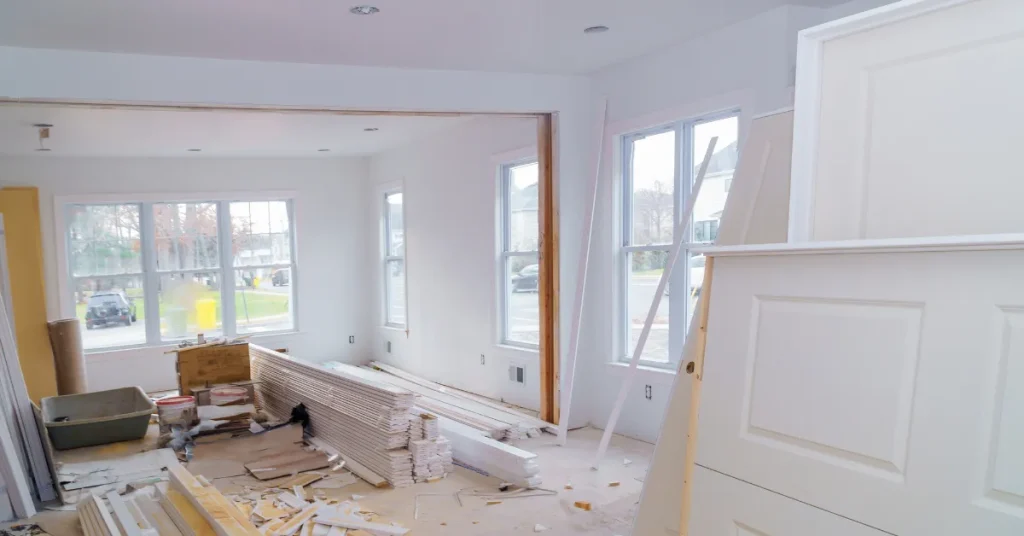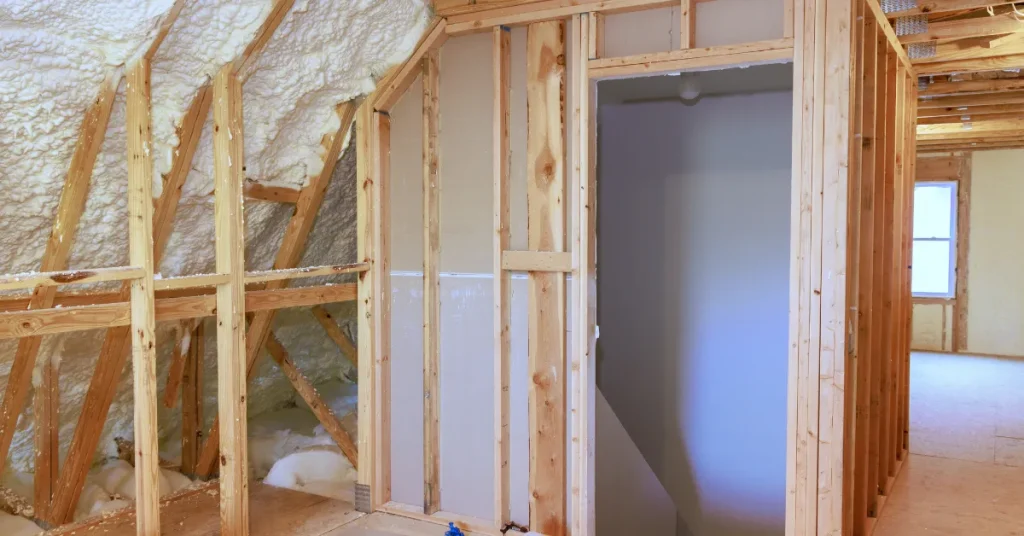R25 insulation is typically 8 inches thick. It offers a high level of thermal resistance for buildings.
Insulation plays an essential role in maintaining energy efficiency in homes and commercial spaces.
R25 insulation, with its substantial thickness, is an effective barrier against heat transfer, helping to keep indoor temperatures stable regardless of the outside climate.
This specific insulation rating is particularly suitable for areas with harsh weather conditions where superior insulation is a necessity.
By reducing the need for heating and cooling systems to work overtime, R25 insulation ensures cost savings on energy bills and contributes to a more sustainable living environment.
A well-insulated building not only enhances comfort but also lowers the carbon footprint by reducing energy consumption.

Essentials Of R25 Insulation
Choosing the right insulation for your space is crucial. R25 insulation provides excellent thermal resistance.
It’s designed to keep homes warm in winter and cool in summer. Understanding the thickness of R25 insulation helps in making an informed decision.
Material Composition
R25 insulation is made from various materials. Among them are fiberglass, mineral wool, and foam.
Each contributes to its ability to prevent heat transfer. They are also environmentally friendly. R25 typically has a thickness of around 8 inches, but this can vary by material.
Common Uses
R25 insulation is used widely in residential and commercial buildings. It’s a popular choice for areas that experience extreme temperatures. Here are some common places you’ll find R25 insulation:
- Attic spaces: Keeps homes warm without using extra energy.
- Walls: Essential for maintaining a consistent indoor temperature.
- Floors: Offers a barrier against cold rising from the ground.
Measuring Insulation Thickness

Knowing insulation thickness is crucial for energy savings. Insulation thickness can affect your home’s warmth. Properly measuring insulation thickness ensures effectiveness.
Industry Standards
Insulation performance relates to thickness. R-value signals insulation effectiveness. Industry standards indicate R25 insulation averages around 8 inches thick. This may vary due to material and manufacturer.
- Fiberglass batts: 8 to 8.5 inches
- Cellulose: around 8 inches
- Foam boards: depends on the material
Different materials require different thicknesses to achieve R25. Higher R-values generally mean better insulation.
Tools For Measurement
Certain tools help achieve precise measurements. A standard tape measure can work well. An infrared thermometer can also check for insulation consistency. Some professionals use specialized equipment for detailed analysis.
- Standard Tape Measure
- Infrared Thermometer
- Insulation Thickness Gauge
Always measure in several locations. Take the average for the most accurate thickness. Consult a professional for complex situations.
The Thickness Of R25 Insulation
Understanding the thickness of R25 insulation is crucial for effective thermal regulation. The correct thickness ensures efficient energy use and comfortable living spaces.
Typical Dimensions Of R25 Insulation
R25 insulation often comes in pre-cut batts or loose-fill materials. Here’s what you typically find:
- Pre-Cut Batts: These usually measure around 8 inches thick.
- Loose-Fill: The thickness can vary. The installer will measure it during installation.
These dimensions provide optimal performance for most climates. But, other factors can change the needed thickness.
Factors Influencing Thickness
Different elements affect how thick R25 insulation should be. Here are some key factors:
| Factor | Impact on Thickness |
| Climate Zone | Warmer zones may need less; colder zones might need more. |
| Space Constraints | In tighter spaces, high-performance options with less thickness might be needed. |
| Building Codes | Local codes can dictate minimum or maximum thickness levels. |
| Material Type | Some materials have higher R-value per inch, affecting total thickness. |
Always check local building codes and consult a professional. This ensures your insulation meets the requirements and performs well.
Performance Metrics
Understanding the performance metrics of R25 insulation reveals how it stands as a barrier against the cold and heat.
Key indicators, including R-value and energy efficiency, highlight the utility of this insulation thickness. Let’s decode these metrics.
R-value Explained
R-Value measures insulation’s ability to resist heat flow. The higher the R-Value, the better the insulation’s thermal resistance. R25 insulation provides an R-Value of 25. This means a solid defense against temperature changes.
Impact On Energy Efficiency
Insulation with a high R-Value like R25 can significantly reduce energy costs. It retains heat during winter and keeps cool air inside during summer. This results in less strain on heating and cooling systems, slashing energy bills.
Consider these points that demonstrate the efficiency of R25 insulation:
- Consistent indoor temperature: A stable climate regardless of outdoor conditions.
- Reduced carbon footprint: Lower energy use means a greener home.
- Increased comfort: Fewer drafts and cold spots.
Ultimately, the true thickness of R25 insulation, typically 8.25 inches for fiberglass, not only enhances comfort but also promotes energy conservation.
Installation Best Practices
Installing R25 insulation requires careful attention to detail. The effectiveness of the insulation largely depends on the precision of the installation process. By following best practices, ensure your home stays warm in winter and cool in summer.
Preparation Steps
Good preparation sets the stage for a successful installation. Begin by gathering the necessary tools and safety gear. Gloves, a tape measure, and a utility knife are essential.
Next, clear the workspace of any debris or obstructions. Ensure the area is dry to prevent any moisture-related issues. Measure the space accurately to cut the insulation to the correct size.
- Measure the space where you’ll add the insulation,
- Check for wiring or pipes that might need special treatment,
- Wear protective clothing and gear at all times.
Techniques For Accurate Fitting
R25 insulation generally measures around 8 inches thick, but the key to maximizing its efficiency lies in accurate fitting. Use a framing square to ensure cuts are straight.
| Step | Technique |
| 1 | Measure twice, cut once – accuracy is crucial. |
| 2 | Square your cuts – this keeps edges flush against framing. |
| 3 | Fit snugly – no gaps for air to pass through. |
Fill gaps with spray foam insulation for an airtight seal. Work in sections to keep things manageable. Ensure a tight fit around obstacles like pipes and wiring.
Lastly, double-check the fitment of the insulation. Eliminate air gaps and smooth out any bunching. Precise cutting and fitting make R25 insulation most effective.
Upgrading To R25 Insulation

Keeping your home cozy and energy-efficient means having the right insulation. R25 insulation is a popular choice for many homes.
The “R” stands for resistance to heat flow. A higher “R” value means better insulation. R25 insulation has a thickness that varies but typically measures around 8 inches.
When To Upgrade
Is your current insulation not cutting it? Here are signs it’s time for an upgrade:
- Higher energy bills signal poor insulation.
- Cold drafts or uneven temperatures in rooms show insulation weaknesses.
- Older homes often need better insulation to meet modern standards.
Cost-benefit Analysis
Consider the return on investment with R25 insulation. The initial cost may be higher, but the savings are significant:
| Aspect | Benefits |
| Energy Efficiency | Keeps heat in, meaning less energy is used. |
| Cost Savings | Reduced energy bills save money over time. |
| Comfort | A comfortable home environment year-round. |
Getting professional advice is key. They can provide personalized insights into the potential savings with R25 insulation. Upgrading insulation is a long-term investment. Your home will feel more comfortable, and your wallet will thank you.
FAQs About How Thick Is R25 Insulation
How Thick Is R30 Insulation?
R30 insulation typically measures about 9. 5 inches thick. This thickness ensures effective thermal resistance for attics and ceiling applications.
What Is The R-value Of 3 Inch Fiberglass?
The R-value for 3-inch fiberglass insulation typically ranges between 9 and 11. This measurement indicates its thermal resistance capacity.
What Is The R-value Of 6 Inch Fiberglass Insulation?
The R-value for 6-inch fiberglass insulation typically ranges from R-19 to R-21.
What Is The Thickness Of R20 Insulation?
The thickness of R20 insulation typically measures around 6 inches (152 mm). It’s designed to offer effective thermal resistance in various building applications.
Conclusion
R25 insulation offers substantial thickness for enhanced thermal efficiency. Typically measuring around 8 inches, it’s a solid choice for attaining energy savings.
Remember, correct installation is key to maximizing R25’s benefits. Embrace this insulation type for a cozier, eco-friendlier home environment.
Choose R25 for reliable thermal resistance.
Resources:
1. https://www.energy.gov/sites/prod/files/guide_to_home_insulation.pdf
